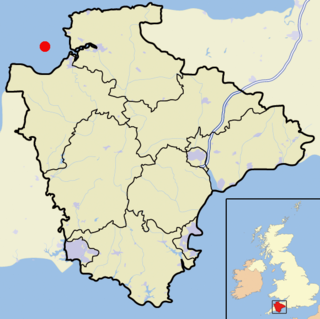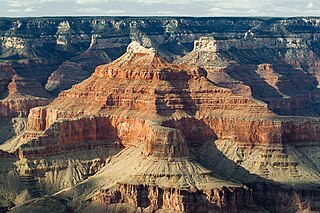
Mermaid's Pool to Rowden Gut is a geological Site of Special Scientific Interest (SSSI) in north-western Devon in England. It comprises a 5.5km-long stretch of coast between Mermaid's Pool in the north-east and Rowden's Gut in the south-west. The sea cliffs expose the only available complete sequence through the Bideford Formation of the Culm Measures, which consists of alternating layers of mudstones, siltstones and sandstones [1] that were deposited in a wide range of deltaic environments during the Carboniferous period. [2] This site borders the Westward Ho! Cliffs SSSI to the north, while the coastline to the south-east continues to Peppercombe, and further into the Hobby to Peppercombe SSSI.

A Site of Special Scientific Interest (SSSI) in Great Britain or an Area of Special Scientific Interest (ASSI) in the Isle of Man and Northern Ireland is a conservation designation denoting a protected area in the United Kingdom and Isle of Man. SSSI/ASSIs are the basic building block of site-based nature conservation legislation and most other legal nature/geological conservation designations in the United Kingdom are based upon them, including national nature reserves, Ramsar sites, Special Protection Areas, and Special Areas of Conservation. The acronym "SSSI" is often pronounced "triple-S I".

Devon, also known as Devonshire, which was formerly its common and official name, is a county of England, reaching from the Bristol Channel in the north to the English Channel in the south. It is part of South West England, bounded by Cornwall to the west, Somerset to the north east, and Dorset to the east. The city of Exeter is the county town. The county includes the districts of East Devon, Mid Devon, North Devon, South Hams, Teignbridge, Torridge, and West Devon. Plymouth and Torbay are each geographically part of Devon, but are administered as unitary authorities. Combined as a ceremonial county, Devon's area is 6,707 km2 and its population is about 1.1 million.

The Culm Measures are a thick sequence of geological strata originating during the Carboniferous Period that occur in south-west England, principally in Devon and Cornwall, now known as the Culm Supergroup. Its estimated thickness varies between 3600 m and 4750 m though intense folding complicates it at outcrop. They are so called because of the occasional presence in the Barnstaple–Hartland area of a soft, often lenticular, sooty coal, which is known in Devon as culm. The word culm may be derived from the Old English word for coal col or from the Welsh word cwlwm meaning knot.

Mermaid's Pool is a little pool in the shore platform a mile west of Westward Ho! It borders on a reef of hard sandstone which stands out against the surrounding gullies formed of easily eroded softer mudstone, now covered in algae. Several minor faults are visible along the length of the reef. [3] There is bladder wrack growing in the area supporting a population of flat periwinkles, which are otherwise not found on the rocky platforms to the east in Westward Ho! [4]

Westward Ho! is a seaside village near Bideford in Devon, England. The A39 road provides access from the towns of Barnstaple, Bideford and Bude. It lies at the south end of Northam Burrows and faces westward into Bideford Bay, opposite Saunton Sands and Braunton Burrows. There is an electoral ward with the same name. The population at the 2011 census was 2,112.
In geology, a fault is a planar fracture or discontinuity in a volume of rock, across which there has been significant displacement as a result of rock-mass movement. Large faults within the Earth's crust result from the action of plate tectonic forces, with the largest forming the boundaries between the plates, such as subduction zones or transform faults. Energy release associated with rapid movement on active faults is the cause of most earthquakes.

The Littorinidae are a taxonomic family of over 200 species of sea snails, marine gastropod molluscs in the clade Littorinimorpha, commonly known as periwinkles and found worldwide.












